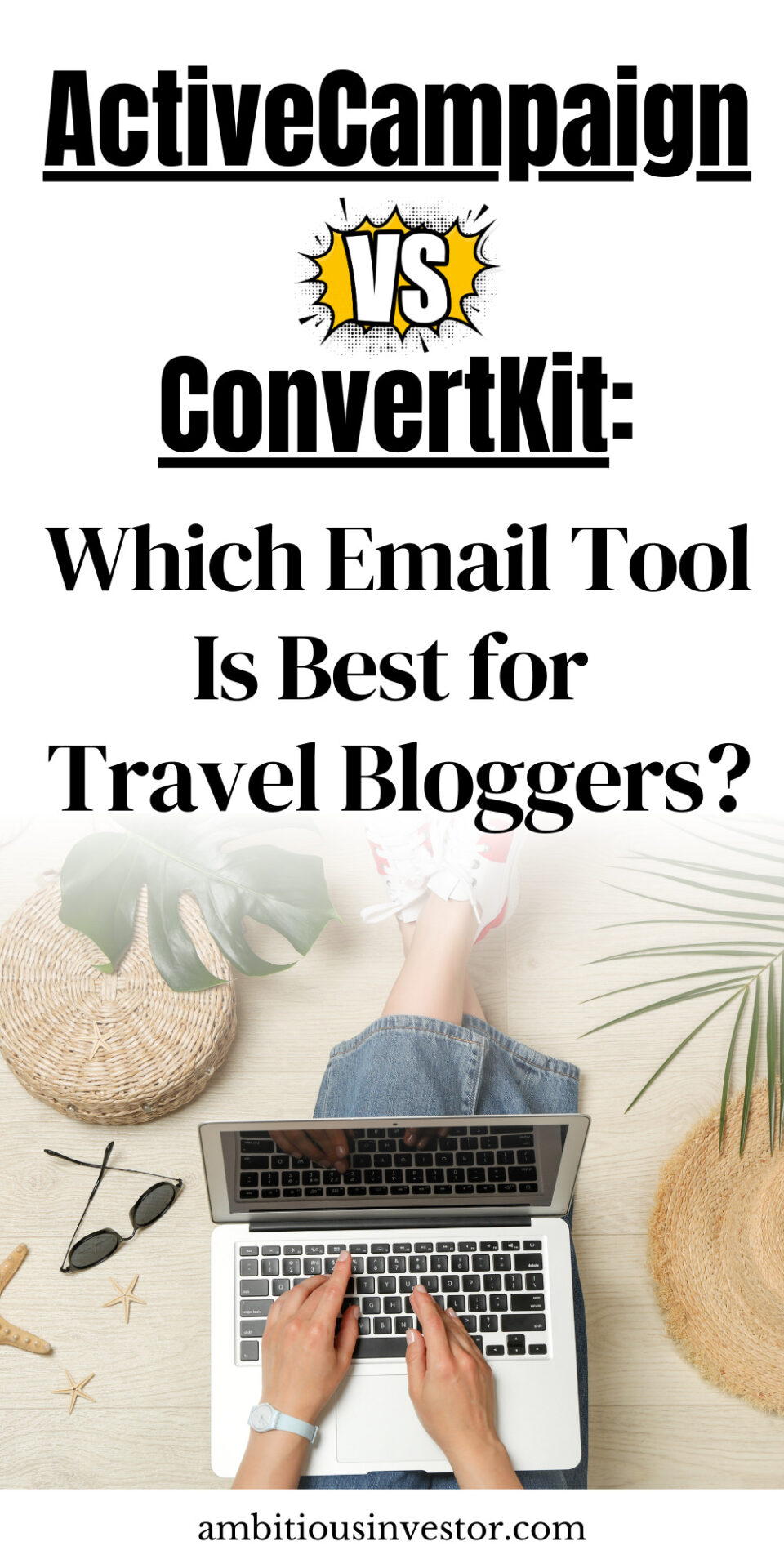ActiveCampaign vs. ConvertKit: Which Email Tool Is Best for Travel Bloggers?
A well-nurtured email list can be your secret to more blog traffic, increased engagement, and higher blogging income. But which email marketing software will help you achieve your email marketing goals quickly and effortlessly? ActiveCampaign or ConvertKit?
Both are popular email marketing platforms with useful automation features. However, as you dig deeper, you’ll discover that they approach email marketing differently—which will affect your overall experience.
The good news is we’ve done the heavy lifting for you. No need to waste time testing each tool yourself.
In a nutshell, here’s our ActiveCampaign vs. ConvertKit review observation.
- ConvertKit is a more beginner-friendly email marketing service that focuses on simplicity.
- ActiveCampaign offers a comprehensive marketing platform with additional features like SMS marketing, CRM features, and E-commerce.
Depending on the scale and goals of your travel blogging business, one tool might suit you better than the other. Read on to discover all the differences between these email marketing tools in detail and choose a winner yourself.
Activecampaign vs. Convertkit at a Glance
If you’re looking for software with a comprehensive suite of marketing tools, ActiveCampaign will impress you. It has robust reporting tools, an advanced automation workflow editor, and powerful A/B testing features.
This marketing-oriented tool might make more sense if you have developed your travel products, created an agency, or have merch requiring a high-level sales funnel. The CRM tool will help you automate sales processes.
ConvertKit might suit you better if you seek a simple but effective email marketing service. It doesn’t try to include everyone from advanced marketers to big businesses like ActiveCampaign does. Instead, ConvertKit markets itself as a tool for creators. Most busy bloggers, including travel bloggers, will appreciate the simplicity of ConvertKit.
In other words, you’ll undoubtedly get the essential functionality from these two popular email marketing services. But how you approach your blogging business will dictate which email marketing software works best for you.
Let’s explore the core differences to give you a better breakdown of how ConvertKit and ActiveCampaign compare.
ConvertKit vs. ActiveCampaign: Pricing
You probably have a budget for your email marketing needs—we all do! So let’s start with pricing!
ActiveCampaign Pricing
Here are the ActiveCampaign pricing plans.
Free trial: a 14-day free trial with no credit card required.
Lite: $29.00/mo for 1,000 contacts
Plus: $49 per month, paid yearly for up to 3 users.
Professional: $149 per month, paid yearly for 5 users.
Enterprise: 10 users (customized pricing).
It is best to compare each pricing plan’s features to ensure you can access all the tools you need to create great customer experiences and achieve your business goals. For instance, the Lite version is the cheapest but doesn’t include landing pages, SMS, and Facebook lead ads.
ConvertKit Pricing
Below is an overview of ConvertKit’s pricing plans.
Free trial: 14-day free trial
Free Plan: Free for up to 1,000 subscribers (limited features)
Creator: $25/month for up to 1,000 contacts
Creator Pro: $50/month for up to 1,000 contacts
Each ConvertKit pricing plan includes the major features. However, some advanced features are available in the Creator and Creator Pro plans, which accounts for the difference in pricing. Compare the features first to see if the plan in your budget has everything you need.
Get started with ConvertKit today.
Verdict
It would be unfair to compare ConvertKit and ActiveCampaign pricing plans directly because of the differences in features. If you utilize the range of tools ActiveCampaign offers, it’ll be a good value for your money.
But if you’ll use the basic email marketing functionalities only, ConvertKit is more budget-friendly. Both tools have a 14-day free trial, but ActiveCampaign doesn’t offer a limited free-forever plan like ConvertKit.
Activecampaign vs. Convertkit: Ease of Use and Learning Curve
Converkit has a shallow learning curve and a well-designed user interface. It offers an easy-to-use editor. Generally, you’ll find it easy to locate whatever you need from your initial use. So if you’re new to email marketing or are a busy creator, ConvertKit is made for you.
You can also find plenty of valuable resources to guide you on how to use ConvertKit features.
ActiveCampaign has a steeper learning curve because of its advanced and detailed features. It can be a bit overwhelming for newbies. But it is worth mastering if your online business would benefit from the toolset.
ActiveCampaign vs. ConvertKit: Email Automation
Email automation is like having a 24/7 marketing assistant who tirelessly delivers your targeted and customized messages at the perfect time—freeing you up to focus on other important tasks.
For instance, you can automate your welcome emails when someone subscribes to your email list or reminders for abandoned carts if you sell digital products.
ActiveCampaign Email Automation
ActiveCampaign has a user-friendly flowchart-style visual editor to help you create relevant email automations. The basic Start/Stop features allow you to control contact inclusion or exclusion from automation workflows based on their actions.
You can play around with the workflows and track contact engagement with tags based on your needs.
When using ActiveCampaign, you should leverage AI tagging, site tracking, and various automation actions. It will help you understand your subscribers’ needs better and achieve virtually infinite possibilities in your campaigns.
ConvertKit Email Automation
ConverKit offers a powerful, simple, intuitive email automation workflow builder. It follows the typical “if this, then that” logic. You can tag and segment your contacts based on different automation rules and date-based triggers.
You can build your automation workflows from scratch or use the numerous templates available on the platform. It has templates for almost every content type and industry, including book and podcast releases.
If you’re new to building highly focused email automation campaigns, ConvertKit has your back. It offers easy-to-follow guides to help you navigate with ease.
Verdict
Choose ConvertKit if you want to build your automation workflows for regular newsletters, one-off email broadcasts, or any other campaigns easily.
If you need advanced features or have complex sales funnels, go for ActiveCampaign. It lets you pair your automations with a CRM integration to promote your business and increase sales. It also allows you to automate several tasks in your Facebook ad campaigns via the Facebook Custom Audiences feature.
ConvertKit vs. ActiveCampaign: Forms
ActiveCampaign Forms
ActiveCampaign offers four form types (floating bar, modal pop-up, floating box, and inline form).
The form builder is easy to use, and you can collect information through the standard fields (name and email) or add customized options.
However, if you’re using the Lite plan, you can only access the inline form option, limiting the form styles for budget users. But that’s not a major deal breaker for most online business owners. The goal is simple, easy-to-use, and effective opt-in forms—not sophisticated designs.
After creating your form, ActiveCampaign allows you to implement it by embedding a code, getting a direct link, using a WordPress plugin, and posting to Facebook.
ConvertKit Forms
ConvertKit form builder is easy to use. You choose the display format (inline, modal, slide-in, or sticky bar) and select a form template. While building your opt-in forms from scratch is possible, templates will save you time.
All you have to do is edit everything you need to change, including the form name, the button text, colors, headings, etc., to suit your brand. Editing is as simple as clicking any field and writing whatever you like. You can also add, re-label, and rearrange form fields.
Once you’ve created your form, ConvertKit allows you to embed it directly on your blog or site. You can also get a direct link.
Verdict
ConvertKit and ActiveCampaign offer simple and intuitive form builders. Each platform offers four display options and allows you to create several forms for your blog/site. It’s a tie here!
ConvertKit vs. ActiveCampaign: Landing Pages
Landing pages are effective tools for driving targeted traffic and encouraging visitors to take specific actions, such as signing up for a newsletter, downloading a free resource, making a purchase, or requesting a consultation. They are also effective in promoting events, webinars, and product launches.
ActiveCampaign Landing Pages
ActiveCampaign offers a wide selection of attractive landing page templates which you can easily customize to suit your brand and goals.
Here’s a summary of what you can do with ActiveCampaign’s landing page builder.
- Use the drag-and-drop functionality to create unlimited landing pages within minutes
- Choose your own domain for landing page URLs
- Display landing pages differently on mobile and desktop
- Personalize landing page content based on user location
- Add a form to your landing page to generate leads
- Add site tracking & analytics code to measure success
- Track users’ landing page activity
- Integrate PayPal for product sales
- Save customized landing page templates for future use
- Optimize landing pages for SEO and social media
ConvertKit Landing Pages
You can use ConvertKit landing pages as stand-alone opt-ins hosted by the platform or on your website. So, you can build an email list as you build your website when starting.
ConvertKit gives you a shareable link for each landing page you create. You’ll find several landing page templates which you can customize. The landing page builder also allows you to change the background, button, text, and font colors, or add images and social media links.
Verdict
If you want additional features on your landing pages, such as forms, chatbots, and automation tools, go for ActiveCampaign. However, note that the Lite plan doesn’t include landing pages. You’ll need the Plus plan or higher.
If you need to create landing pages before your site goes live and you’re on a budget, go for Converkit. All the ConvertKit pricing plans allow you to create unlimited landing pages.
ConvertKit vs. ActiveCampaign: Segmentation and Targeting
If there’s a tried and true email marketing strategy that you should focus on, it’s subscriber segmentation. It’s the key to delivering personalized experiences and building a loyal email list of people eager to hear from you.
Here’s Hubspot’s research data to support the claims for the top three most effective strategies for email marketing campaigns.
- Subscriber segmentation (78%)
- Message personalization (72%)
- Email automation campaigns (71%)
ActiveCampaign Segmentation and Targeting
You can manage subscribers in ActiveCampaign in two ways: list and tags. Think of it as adding a sticky note to each contact so you can send them what they really want to see. You can go for multiple lists or a single list with multiple tags.
To truly harness the platform’s potential, automated tagging is the way to go. It allows you to set up conditions in automation workflows to effortlessly tag subscribers based on their actions, like clicking specific email links.
And things get magical when you pair ActiveCampaign’s tagging system with site tracking. This dynamic duo enables you to tag subscribers based on their interactions with your website, unlocking valuable insights into their interests.
People show you what they care about by their actions and how they interact with your content. For instance, if someone visits your product page, you can add a tag for “product interest” and send related content when they opt in.
ConvertKit Segmentation and Targeting
ConvertKit uses a subscriber centric approach, meaning you’ll have only one list of subscribers. Then you can use tags to organize and group your subscribers into different segments, based on various criteria such as their actions, interests, etc.
Verdict
Segmentation focuses on one fact: Not every subscriber cares about every aspect of your content. For a better connection, you must ensure you send relevant content by tagging and segmenting your audience properly.
ActiveCampaign offers advanced segmentation, making a more powerful email marketing platform for managing larger audiences.
ConvertKit vs. ActiveCampaign: Responsive Email Templates
ActiveCampaign Email Templates
If you want a large selection of customizable email templates, ActiveCampaign will sort you. It offers over 55 pre-designed email templates. You’ll find everything from modern designs for various industries to more basic templates.
The email builder is also quite powerful for anyone who wants to create email campaigns from scratch. It offers a lot of design flexibility and an easy learning curve. And if you’re a subscriber of the Plus plan or higher, you can request a custom email template designed by ActiveCampaign.
ConvertKit Email Templates
ConvertKit offers only three email templates and a powerful email builder. While in other aspects of email marketing we highlight that templates save you time, you might be better at creating your own email templates.
The email editor offers several formatting options that allow you to change the font, color, and alignment from a simple formatting bar. You can also add lists, personalization headers, buttons, dividers, and more through the context menu.
Verdict
If you want multiple pre-designed templates, go for ActiveCampaign.
If creating your email templates sounds better or you’ll only send text-based emails, Converkit will suffice.
ConvertKit vs. ActiveCampaign: A/B Testing
ActiveCampaign is quite generous with the customizations of its A/B testing feature. It lets you test different subject lines, email content, and layouts to determine which version resonates best with your audience.
When creating a new email campaign, you must select the “Split Testing” option. As you progress with the setup, you can choose the type of variable to test: subject lines or email templates.
ActiveCampaign will split your audience into smaller segments and send different versions to each group. The feature lets you choose when the winner should be determined (during or after the campaign) and the ratios for dividing your contacts.
With this tool, you can gather valuable insights and make data-driven decisions to improve your email marketing strategy.
ConvertKit A/B Testing
ConvertKit currently supports A/B testing for subject lines only. You cannot test other elements of email marketing, for instance, templates or content.
ConvertKit sends each subject line to 15% of your contacts and waits four hours to determine the winner based on open rates. After 4 hours, the platform sends the winning subject line to the remaining 70% of your email subscribers who were not part of the initial test.
Verdict
ConvertKit and ActiveCampaign have very different approaches for the A/B testing. If you want more control regarding the ratios for dividing your contacts and determining when you know the winner, ActiveCampaign is the way to go. It is also a good option if you want to test other email elements beyond subject lines.
If you only test subject lines and like ConvertKit’s approach, go for it.
ConvertKit vs. ActiveCampaign: Integration with Third-Party Tools
ActiveCampaign Integrations
ActiveCampaign makes integrating with third-party applications a breeze.
With over 150 integrations available, including popular platforms like WordPress, Stripe, and Shopify, you have many options.
Related: Learn how to set up a Shopify store
What sets ActiveCampaign apart is its user-friendly documentation. Each integration has a breakdown of how it works, ensuring a seamless setup process.
In case you can’t find a specific integration, don’t worry. ActiveCampaign has you covered with its integration with Zapier.
You can also leverage the straightforward API integration to create custom integrations tailored to your needs.
ConvertKit Integrations
ConvertKit provides 100+ integrations, including popular platforms such as Shopify, Clickfunnels, Wix, Gravity Forms, Stripe, and Thinkific.
It also offers integration options through Zapier, enabling connectivity with thousands of third-party services and apps.
And if you want to build custom integrations, ConvertKit supports API-based custom integration.
Verdict
The major differences between Converkit’s and ActiveCampaign’s integrations are the number of native integrations and CRM features.
ActiveCampaign has more native integrations than ConverKit.
Notably, Coverkit doesn’t have its own CRM system, so you might need to use Zapier.
ConvertKit vs. ActiveCampaign: Tracking and Reporting Feature
How do you know the effectiveness of your email campaigns? What are your sales performance metrics if you’re selling items online?
ActiveCampaign Tracking and Reporting
ActiveCampaign’s tracking options include:
- Open/read tracking
- Link tracking
- Reply tracking
- Google analytics
- Site Tracking’
You need to set up these options before sending your emails. The platform is also thorough with reporting for every campaign.
You’ll get detailed data on opens, page visits, click maps, and geo-tracking. You can even tag users based on their actions during the campaigns. For instance, you can resend an email to those who didn’t open it.
CoverKit Tracking and Reporting
CoverKit tracking and reporting provide limited and basic reporting metrics. Unfortunately, there is no dedicated section for reporting and analytics.
The available analytics data is only accessible at the individual sequence or email level. It includes metrics such as click rates, open rates, links clicked, and unsubscribers. However, important features like click maps, geographical data, and bounce rate data are missing in Coverkit’s reporting capabilities.
Verdict
Understanding the results of your email marketing efforts can help you learn more about your audience.
ActiveCampaign stands out as an email marketing tool with advanced reporting and tracking features. ConverKit also offers campaign results but not as detailed as ActiveCampaign.
ConvertKit vs. ActiveCampaign: Customer Support and Training
ActiveCampaign offers a comprehensive knowledge base, with everything you need to know about the platform. There are videos, recorded webinars, and how-to articles. You’re almost guaranteed to find resourceful materials for any questions you have about the platform.
You can also reach the ActiveCampaign’s support team via email, live chat, or phone. Their response rate is not the fastest but is satisfactory.
If you need help from the community, you can check out the relevant Facebook groups and forums. We found two, one official and another non-official with very active members.
ConvertKit Customer Support
ConvertKit offers customer support through multiple channels. Users can contact the support team via live chat and email on weekdays (Monday to Friday).
In addition to direct support, ConvertKit provides a robust knowledge base. This resource contains a wide range of detailed articles that cover various topics, including common issues and troubleshooting steps. Users can leverage these resources to find solutions to their queries independently.
ConvertKit has an online support forum. This forum allows users to engage with the ConvertKit community and seek help from fellow users. This peer-to-peer support system can be a valuable source of information and assistance.
ActiveCampaign vs. ConvertKit final thoughts
Have you picked a winner that suits your needs better?
Both ActiveCampaign and ConvertKit are popular email marketing services that offer a range of features for building a list, managing subscribers, and automating email campaigns.
ActiveCampaign aims to be an all-in-one digital marketing automation tool. It has everything you’ll find a basic email marketing software but it takes each feature a notch higher. It also offers additional features you won’t find in ConvertKit like Facebook custom audiences, CRM, and lead scoring.
Multiple advanced features sounds all good but for some bloggers, you might not use most of them.
If you’re not into advanced marketing automation, a simple but effective email marketing service like ConverKit will work well for you.
Evaluate your needs, goals, and skill-level to choose the tool that aligns well.









